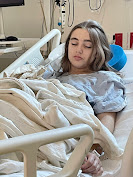I’m normal here. My bike is normal here, was one of my first thoughts as I looked around at the Wheels To Succeed bike event.
Wheels To Succeed is a program sponsored by Our Lady of The Lake and McMains Children’s Development Center that provides kids with developmental disabilities adaptive bikes. Adaptive bikes are very important for the well-bring of kids who can’t ride bikes with two wheels because riding a bicycle is a fundamental part of childhood. Adaptive bicycles cost thousands of dollars because they are so specialized, so the event is partly a fundraiser, and partly a chance for kids with disabilities to ride their bikes with others like them.
The sense of normalcy I experienced at Wheels To Succeed was definitely different for me. Usually, I am not considered normal. I was featured in an article once (actually, it was an article about getting my adaptive bike) and the article began: “It was a normal sunny day….What was not normal was Ainsley or her bike.”
And the article was right. For so long I’ve resisted the idea that “normal” exists. It shouldn’t exist and it may be a societal construct, but “normal” does exist. It’s just that “normal” differs for people depending on their perspective.
For example, able-bodied people—people who don’t have disabilities or health challenges—probably think that a person with a disability, or a person who uses mobility equipment, etc., isn’t normal. My normal is having pain every day, and that is considered abnormal for most people. My normal is bloodwork and shots and physical therapy and IEP meetings, and diagnoses that don’t quite fit. Sometimes medicine can’t explain me, and for me that’s normal.
My point is that normal does exist in society. I could argue until I’m blue in the face that normal isn’t real, but I would be wasting my time. It is a waste of effort to try to convince people who will never think I’m normal that it doesn’t exist.
However, what is true is that normalcy isn’t automatically a good thing. Being normal isn’t a wonderful personality trait; it’s just an opinion. Although, I think it is human nature for people to crave belonging.
I never really feel like I belong anywhere. I don’t appear to be disabled, but I need help with things that most able-bodied people don’t. I’m right in between two worlds. I’m the intersection in the Venn diagram. When I try to claim a disability identity, I feel like it will never be valid enough. But I can’t make my cerebral palsy disappear, either, and I wouldn’t want to.
Overall, it is easier to fit in with the disability community because nothing is considered wrong or too strange. I feel more comfortable there because I don’t have to defend my disability. I can just be…Ainsley. In other places my CP is surprising—never a good surprise. But I can be myself in the disability community.
Wheels To Succeed was great for me because it improved my self-confidence. People were happy for me when I finished the bike race—without any strings attached. I was able to ride my bike without any judgment, and with other kids like me. My bike was normal at Wheels To Succeed. I was normal.
I struggle to admit this to myself, but sometimes I just want to fit in. My CP is so mild that I don’t really feel seen in the disability community—but that’s kind of the point. I don’t stand out, so I can just be me. I get to claim a disability identity that is rightfully mine. I get to have fun being active on my own ability level.
I got to finish a bike race like a “normal” kid—but I’m not, and that’s what’s beautiful about an event like Wheels To Succeed.













